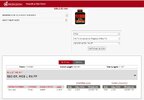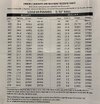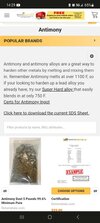JimGnitecki
Member
- Joined
- Mar 28, 2010
- Messages
- 1,258
By buddy brought me at least 50 to 75 lb of wheel weights that he has had for "over 30 years", from when he used to cast bullets (He no longer does, as he shoots F-Class almost exclusively at age 72).
I washed 23.6 lb of them with hand dishwashing detergent, rinsed them, and laid them out to dry thoroughly (no desire to meet "The Tinsel Fairy!). The next morning, I melted them, removed the clips, fluxed thoroughly with sawdust, and cast them into 30 ingots.
6 hours after pouring the ingots, I sample tested their hardness using the Lee Hardness Tester on 4 different ingots, and got absolutely consistent results: BHN = 9.8.
21 hours after pouring the ingots, I still only get BHN = 10.
I realize wheel weights hjave changed composition over the decades.
The From Ingot to Target: A Cast Bullet Guide for Handgunners book written in 2011 says that the Lead alloy from wheel weights typically tests at BHN 10 to 12, so mine APPEAR to be "typical", and back 30 years ago were apparently called "hard"!
My intended usage is for 500g cast bullets for my Pedersoli Sharps replica "buffalo rifle".
The Hodgdon load table for a 500g cast bullet used at "Trapdoor" pressures looks like this:

And yes, 5744 is the powder I have.
Note that the pressure range from minimum load to maximum load is 15,900 psi to 18,800 psi. This is low for firearm cartridges in general, BUT Richard Lee's Modern Reloading book suggests that such a pressure range requires a BHN of about 12.4 to 14.8, to prevent leading and to optimize accuracy.

The 12 to 14 BHN range is roughly what I was targeting with my earlier available Lead alloys before my buddy sent me these wheel weights and along with a lot (over 50 lb) of pure Lead which is of course even softer. I had thought he was going to send me some Linotype as well, to do some blending to get to my target hardness, but that did not happen.
Now soft Lead alloys are wonderful for good obturation, which Pedersoli rifles apparently really like. But soft Lead alloys also can cause severe leading in the barrel if they are TOO soft for the pressures being generated. So, I have to wonder if using this wheel weight alloy without adding costly Antimony, and maybe some more Tin as well for better casting, might create a hard-to-remove mess in the barrel, as well as destroying accuracy. But Tin and Antimony are both very costly to buy AND to ship here in Canada, and U.S. suppliers don't want to ship to Canada.
My bullets from my Lyman 457125 mold will not accept gas checks, and I don't want to use costly gas checks regardless, because I should not need them in such a low pressure load range.
My only possible partial mitigation to this potential problem is that I am using powder coating, which supposedly allows much higher velocities and pressures than conventional bullet lubricants, without leading a barrel.
Those of you with experience casting Sharps replica rifle bullets: Do I need to buy and add Antimony to harden up this wheel weight alloy, or with the powder coating, might this alloy work despite its softness?
Jim G
I washed 23.6 lb of them with hand dishwashing detergent, rinsed them, and laid them out to dry thoroughly (no desire to meet "The Tinsel Fairy!). The next morning, I melted them, removed the clips, fluxed thoroughly with sawdust, and cast them into 30 ingots.
6 hours after pouring the ingots, I sample tested their hardness using the Lee Hardness Tester on 4 different ingots, and got absolutely consistent results: BHN = 9.8.
21 hours after pouring the ingots, I still only get BHN = 10.
I realize wheel weights hjave changed composition over the decades.
The From Ingot to Target: A Cast Bullet Guide for Handgunners book written in 2011 says that the Lead alloy from wheel weights typically tests at BHN 10 to 12, so mine APPEAR to be "typical", and back 30 years ago were apparently called "hard"!
My intended usage is for 500g cast bullets for my Pedersoli Sharps replica "buffalo rifle".
The Hodgdon load table for a 500g cast bullet used at "Trapdoor" pressures looks like this:

And yes, 5744 is the powder I have.
Note that the pressure range from minimum load to maximum load is 15,900 psi to 18,800 psi. This is low for firearm cartridges in general, BUT Richard Lee's Modern Reloading book suggests that such a pressure range requires a BHN of about 12.4 to 14.8, to prevent leading and to optimize accuracy.

The 12 to 14 BHN range is roughly what I was targeting with my earlier available Lead alloys before my buddy sent me these wheel weights and along with a lot (over 50 lb) of pure Lead which is of course even softer. I had thought he was going to send me some Linotype as well, to do some blending to get to my target hardness, but that did not happen.
Now soft Lead alloys are wonderful for good obturation, which Pedersoli rifles apparently really like. But soft Lead alloys also can cause severe leading in the barrel if they are TOO soft for the pressures being generated. So, I have to wonder if using this wheel weight alloy without adding costly Antimony, and maybe some more Tin as well for better casting, might create a hard-to-remove mess in the barrel, as well as destroying accuracy. But Tin and Antimony are both very costly to buy AND to ship here in Canada, and U.S. suppliers don't want to ship to Canada.
My bullets from my Lyman 457125 mold will not accept gas checks, and I don't want to use costly gas checks regardless, because I should not need them in such a low pressure load range.
My only possible partial mitigation to this potential problem is that I am using powder coating, which supposedly allows much higher velocities and pressures than conventional bullet lubricants, without leading a barrel.
Those of you with experience casting Sharps replica rifle bullets: Do I need to buy and add Antimony to harden up this wheel weight alloy, or with the powder coating, might this alloy work despite its softness?
Jim G


